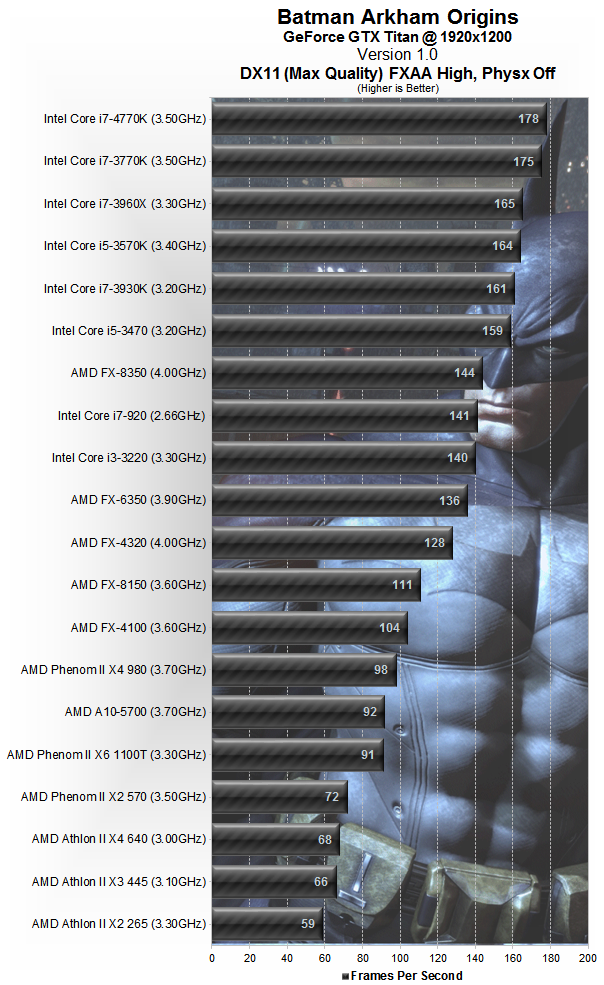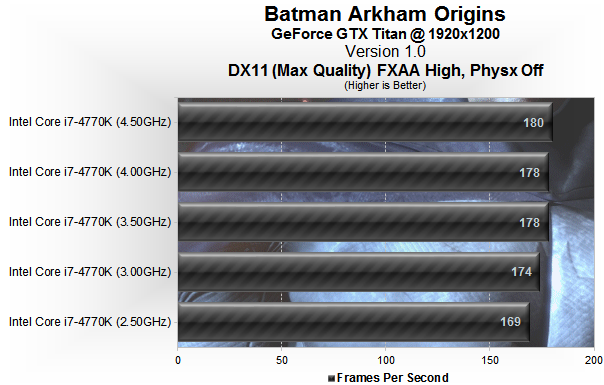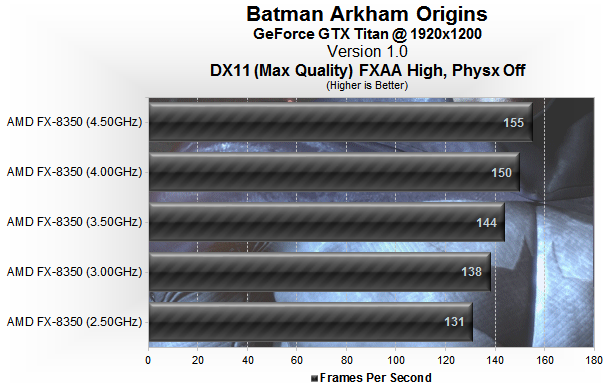CPU Performance & Wrapping It Up

Batman: Arkham Origins utilizes four threads/cores, so you'll naturally want a quad-core processor. Using the GTX Titan for maximum frame rate performance, the Core i7-4770K allowed for 178fps, the old i7-3770K wasn't much slower at 175fps, while the i7-3960X managed 165fp and the Core i5-3570K trailed by 1fps.
AMD's fastest offering (the FX-8350) produced 144fps, or slightly faster than the archaic Core i7-920 and an i3. The Phenom II X4 980 allowed for just 98fps, the Phenom II X6 1100T dipped to 91fps, the Phenom II X2 570 slipped further to 72fps and the Athlon II X4 640 offered only 68fps.
Keep in mind that if we set PhysX to normal and forced the CPU to handle those calculations too, even more processing power would be required.

Clock speed didn't affect the Core i7-4770K much as there was just a 6% drop in performance when going from 4.5GHz to 2.5GHz, so Core i5 and i7 owners probably won't have much to gain from CPU overclocking.

AMD users, on the other hand, could probably stand to benefit from a little overclocking as there was a 15% drop in performance when scaling back from 4.5GHz to 2.5GHz.
Wrapping It Up
Batman: Arkham Origins may not be the year's best-looking release but there are obvious advantages to sticking with Unreal Engine 3, not least of which is optimization, as shown by the game's ability to run smoothly on affordable cards. Controlling the Caped Crusader at, say, 1920x1200 with maximum quality settings and FXAA, you could get by comfortably with the Radeon HD 6870/7850 or GeForce GTX 560 Ti/650 Ti.
Today's mainstream performance cards such as the R9 280X or GTX 760 averaged over 100fps so most gamers should be able to get away with max quality if paired with FXAA. Shifting to MSAAx8 at the same resolution cut the GTX 760's frame rate 47% from 111fps to 59fps, while the R9 280X slipped 49%. To play at 1080p or so with MSAAx8, you'll want at least the GTX 660 or HD 7870 – if possible, the HD 7970 or GTX 760/670.
Flipping PhysX to normal let us enable the effects on Radeons by offloading those calculations to the CPU (an i7-4770K in this case). At 1920x1200, with the CPU handling PhysX for each card, the R9 290X was just 3fps slower than the GTX Titan while the R9 280X was 5fps slower than the GTX 770 and 2fps faster than the GTX 760. Those numbers get 8% to 13% better for Nvidia's products if we allow GPU-accelerated PhysX.
As for CPU performance, any modern quad-core will suffice, though the Core i5s and i7s gave the best showing, though we only posted processor results with PhysX off. When tasked with handling that load too, the quad-core parts didn't have any trouble providing playable performance. The FX-8350 held up fine and although AMD's chips are slower than the competition's, a sliver of the gap can be closed through overclocking.
We're impressed with how well optimized Arkham Origins is on PC. We'll be the first to admit that its visuals won't set any records, but the game looks solid for how well it runs on fairly low-end hardware.


